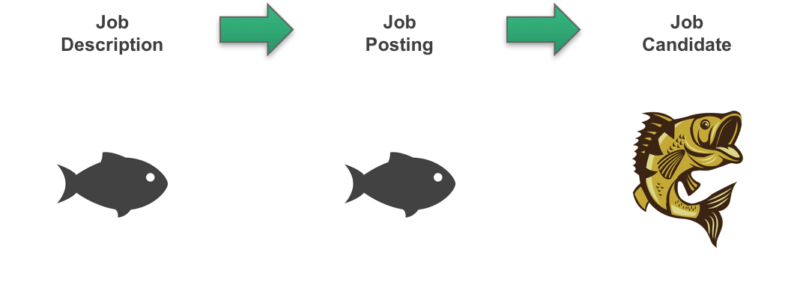Recruitment Strategies for Long-Term Employee Engagement
What is the overarching goal of your recruitment program?
Before your organization can develop effective recruitment strategies, it needs to get recruiters, HR, and leadership on the same page with this simple question. The answer is usually more complicated than simply “to hire top talent” because recruiting affects many parts of your organization in different ways. Your team will need to come to a unified understanding before you can find candidates that will stay in your organization while staying engaged with your organization.
What Stakeholders Want in Employee Recruitment Strategies
This collaboration is essential because everyone at the recruiting table has different needs and priorities:
- Hiring managers have the most invested in this process. Whether the recruitment need comes from turnover or growth, they feel the pain that comes from being short-staffed. They are concerned with finding someone who can perform the skills needed to do the job, and finding them quickly.
- Finance departments want long-term sustainability in their staffing budgets. They want to keep labor costs to a reasonable percentage of your organization’s revenue based on your industry.
- Leadership wants to make sure that each department and team has enough capacity to accomplish your organization’s mission and objectives. Short-staffing on one team can affect the organization’s workflow, leading to bottlenecks that make collaboration delays worse. Leadership also wants to keep turnover from becoming a larger narrative in the organization with the risk of poor experiences spreading to other teams.
- And Recruiters? Recruiters want to do their jobs well by finding the right candidates with the right skills, the right salary requirements, and the right soft skills, all as quickly as possible.
Unfortunately, this balancing act can lead everyone involved to overlook the most important person in the recruitment process: the candidate. Candidates always matter, but in today’s employment market, the employee experience can make all the difference in finding and keeping great people with your organization.
It’s a Candidate’s Job Market
It has now been a decade since the great recession took out financial giants like Lehman Brothers and Merrill Lynch with a market crash that redefined employment for a generation of employees. With high unemployment, organizations could afford to keep their focus on their own needs and still have candidates clamoring for a job―any job.
But in 2018, the US economy hit a different milestone: job openings outnumbered available candidates for the first time in 15 years. This shift in supply and demand means that candidates can be selective about where they work, holding out for opportunities that align with their personal and career goals.
To attract and keep these employees, your organization’s recruitment strategies need to shift to match the current market. With the right understanding and support, recruiters can satisfy hiring managers, finance, and leadership while doing their best to find candidates whose expectations fit with the reality of the position.
Recruitment Strategies to Incorporate Right Away
Slow is Smooth, and Smooth is Fast
The Navy SEALs have a saying: slow is steady, steady is smooth, and smooth is fast. When they say it, they’re talking about performing slow repetitions of actions like jumping from moving vehicles and sighting enemies without panicking.
But the same principle applies to successful recruiting strategies: taking your time to optimize the process may slow things down at first, but as the process becomes steady and smooth, you’ll save time in the long run.
Of course, it’s one thing to talk about discipline and another to practice it when there’s an urgent personnel need. When the pressure is on to fill positions quickly, some may judge a recruitment strategy’s success by how fast it fills an empty seat. This pressure can lead to quick shortcuts that create a poor candidate match. All we can do is encourage you to stay the course. At the end of the day, you don’t need a warm body; you need the right candidate.
Play Your Field: Evaluate How You Are Finding Qualified Job Leads
There are so many different recruitment strategies out there, but most of them include gathering as many leads as possible and sorting through them one-by-one before you find the star player. This method takes a lot of time and stamina that ends up being wasted on the masses.
Focusing instead on finding the few qualified leads in your particular field might take a little more patience upfront, but will pay off in the end when you find the right person for the position.
Evaluate how you are currently finding leads and change course if needed. Know your niche and look in specific talent pools both online and offline. Don’t discount casual job seekers who are somewhat happy where they are, because they are willing to get won over. Finally, communicate openly with as much relevant information as possible. Doing these few things will make a huge difference when looking for just the right fit.
Implement the Secret Weapon of Recruiters
If you want results quickly, it’s time to pull out the secret weapon. Employee referral programs reap benefits such as higher quality hires, with less time and money spent in the hiring process. This is because your employees have already done the sorting and qualifying for you.
Here’s a hint: If a good employee comes to you and says, “Hey, I have a friend who would be great for such-and-such position,” then take action! Chances are good that your employee’s instincts are spot-on.
You can encourage employee referrals by offering incentives and optimizing the process.
Better Interviews = Better Experience
Remember, the interview is the first direct contact a candidate has with your organization. The opportunity to solidify their eagerness to work for you shouldn’t be taken lightly. After all, you are not just interviewing them, they are interviewing you. Today, the labor market is very competitive, and if the candidate has a negative experience, you better believe there is another company ready to recruit them.
Give your interviewees a better experience by:
- Avoiding cookie-cutter questions. Try a more conversational approach instead.
- Offering a strong explanation of your company’s culture and values.
- Explaining, in detail, the role to be filled. Give as much information as makes sense.
Employee Recruiting Examples: The Parable of Lance Bass
(No, not that Lance Bass.)
Let’s say that you’re hiring for a brand new business. The hiring manager outlines the basics for the position in the job ad, the recruiters put it out on the market, and they end up with a great catch: we’ll call him Lance.
Not only does Lance meet the basic requirements, but he grows into the role. His unique talents start to make a difference in his department and in the organization as a whole.

The hiring manager for Lance’s team decides that she wants another Lance. But she can’t put “basically another Lance” in the job ad—no one will know what she’s talking about. So she updates the job ad and emphasizes some of Lance’s unique qualifications in the picture she paints of the position. It’s not an exact picture of Lance, but it includes a lot of Lance’s “nice-to-haves.”

Unfortunately, candidates can’t see the underlying requirements of the job description. They only see what you post. In this example, the caricature of Lance overemphasizes the nice-to-haves at the expense of a clear outline of key qualifications for the job.

Based on what she emphasized and where she posted it, this manager ended up with a completely different species of job candidate, one that won’t be happy for long in Lance’s environment.
The key to developing an effective job description is to start with the essential job requirements instead of a list of a current team member’s attributes or a standard description copied directly from the Internet.
For example, our sales team here at BambooHR operates in a very different environment than most sales teams. We only operate on inbound leads, and often, our conversations have a strong educational component as we help prospects find the right fit for their organization.
We found that the traditional sales job description wasn’t bringing in candidates that were sticking with us. So we broadened our scope, recruiting people with backgrounds in HR, education, and support. Not only did this reduce our turnover in sales, but it also improved diversity on a team that, like many sales teams, was predominantly male.
Identifying the specifics of job requirements takes time and thought. But it’s the first step to finding a candidate that fits the reality of the job.
How Compensation Transparency Affects Your Recruitment Strategies
“But wait,” you might think, “what’s wrong with advertising for fish and getting elephants? Don’t we want the biggest and best we can catch?”
While it’s important to find great candidates, the biggest, most-experienced candidate won’t always be the best candidate for the position. It’s not just about catching great candidates—you have to keep them after they’re caught, and this needs to factor into your recruitment strategy.
For ages, salary decisions were made directly between the employee and the organization. There was also a strong taboo against talking about your salary with your coworkers. The rise of the Internet began adding transparency to this information, but then the recession shifted the focus from salary negotiation to finding a steady salary in the first place.
Today, employees can find a wealth of salary information online, from industry standards to Glassdoor reports from their current organization. And if their outlook for their salary and benefits doesn’t compare well with their neighbors, they now have options for improving it.
Salary Compression Cuts Both Ways
Back to the hiring parable: what happens when you take the plunge and hire an overqualified candidate with a higher salary requirement? On the plus side, you get a qualified candidate right now. But how does Lance feel when he learns that the new guy earns just as much as he does despite Lance’s years of great work with the organization? Suddenly his salary seems less like hard-earned success and more like a bare minimum.
This phenomenon is called pay compression, and it has a huge impact on employee engagement. It’s more than not making enough money—employees facing pay compression can lose faith that their organization understands the value of their work and is willing to support their long-term growth and success.
It’s not much better for the elephants in the fish pond, either: if you have to stretch your budget to hire elephant candidates, how are you going to increase that compensation? And when your budget doesn’t allow it, how long will it take for these employees to notice? Before long, the pattern of salary compression will become a pattern in your working environment as new hires start outearning the previous top talent.
Here are some pay compression scenarios to watch out for during the recruitment process:
- Haggling: It can be tempting to stretch the recruiting budget for a candidate that is just out of reach. But the time your organization spends developing a compensation strategy won’t mean much if you pay candidates at the top of the market just to get them in the door.
- Buddy Inflation: Speaking of compensation strategy, you’ll want to make sure that your organization bases its compensation plan on market research and not on whether a manager can convince the CFO to give more to a certain team or position.
- Start Open, Stay Open: While you don’t have to announce everyone’s salary to every candidate, you can provide a degree of transparency on your compensation practices. Let them know if the position’s pay matches or exceeds the market rates. Or if your organization can’t match market rates, explain the other aspects of your mission that lead candidates to value their work and results.
A Bright Future is the Best Recruitment Strategy
The best recruitment strategies are those that factor in every part of the employee experience. While getting candidates to sign an offer letter is important, it’s just as important to provide a clear onboarding process, regular performance management, and a career path for employees to progress in both salary and responsibilities.
These aren’t factors that a recruiter can fake with a carefully-worded job ad or a spiffy careers page. As potential candidates read these official communications from your organization, they’ll also factor in reviews from current and former employees as part of their research. The sum total of these experiences makes up your employer brand, and your employer brand determines whether your recruiting and retention becomes a destructive or productive cycle.
In the end, recruitment strategies are most effective when candidates understand as much as possible about your organization, your organization understands each candidate, and both sides have the opportunity to grow from a shared experience. As recruiting becomes an extension of your organization’s overall strategy, it becomes easier to create these experiences.
Get caught up every month on all things HR. Don't worry, we promise we won't spam you.
Brian Anderson expertly decodes all things HR, drawing on a decade of technical writing in the business organization industry to provide editorial support to internal and external learning programs at BambooHR. His writing explores the different motivations that shape the employee experience and the psychology of human resources.









